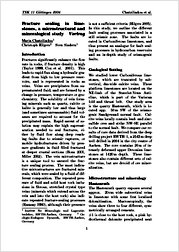Fracture sealing in limestones, a microstructural and mineralogical study
2006Universitätsverlag Göttingen
Sammelband- / Konferenzbeitrag
Verlagsversion
Deutsch
Chatziliadou, Maria; Hilgers, Christoph; Sindern, Sven, 2006: Fracture sealing in limestones, a microstructural and mineralogical study. In: Philipp, S., Leiss, B, Vollbrecht, A., Tanner, D. & Gudmundsson, A. (eds.): 11. Symposium "Tektonik, Struktur- und Kristallingeologie" , Univ.-Verl. Göttingen, 2006, S. 30 - 32., , DOI: 10.23689/fidgeo-1927.
 |
Dokument öffnen: |
Fractures significantly enhance the flow
rate in rocks, if fracture density is high
(Taylor 1999, Cox et al. 2001). This
leads to rapid flux along a hydraulic gradient
from high to low pressure reservoirs,
and is represented in rocks as
veins. Veins are precipitates from supersaturated
fluid, and are formed by a
change in pressure, temperature or geochemistry.
The solubility of vein forming
minerals such as quartz, calcite or
halite is generally low and thus large
(and sometimes unreasonable) fluid volumes
are required to account for the
precipitated mass. Rapid ascent of solution
may explain the high supersaturation
needed to seal fractures, either by fluid flow along deep reaching
faults due to seismic ruptures, or
mobile hydrofractures driven by pressure
gradients in fluid filled fractured
at deeper crustal sections (Bons 2001,
Miller 2002). The vein microstructure
is a unique tool to unravel the fracture
sealing process. The most indicative
microstructures are fractured minerals,
which were sealed by a fluid of different
composition. The repeated presence
of fluid and solid host rock inclusions
in fibrous, stretched crystal type
veins (minerals which extend across the
vein and into the host rock) also indicate
repeated fracture-sealing processes
(Ramsay 1980), although their presence
is not a sufficient criteria (Hilgers 2005).
In this study, we outline the different
fault sealing processes associated in a
still seismic zone. The faults are located
in Carboniferous limestones, and
thus present an analogue for fault sealing
processes in hydrocarbon reservoirs
and an in-depth study of seismogenic
faults.

